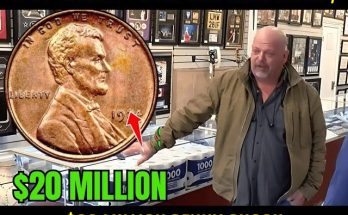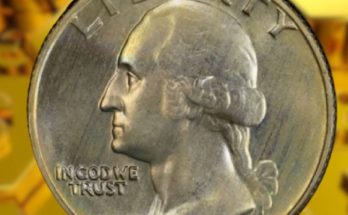🧐 Learn to Identify Valuable and Rare Washington Quarters: Your Guide to the Biggest Finds
The Washington Quarter, first minted in 1932, is one of the most recognizable coins in the United States. While most quarters are worth 25 cents, specific issues from this long-running series are numismatic legends, selling for thousands, and in some cases, six figures. The accompanying images—highlighting the elusive 1932-D and the transitional error year 1965—demonstrate that true value lies in knowing exactly where and what to look for.
🥇 Era 1: The Silver Key Dates (1932 – 1964)
The quarters minted from 1932 through 1964 are all composed of 90% silver, making them instantly valuable beyond their face value. However, the first three years of the series produced the true “keys” due to extremely low mintages.
| Year & Mint Mark | Mintage Notes | Rarity Factor | Estimated Value (Good to VF) |
| 1932-D | Denver Mint. Only 436,800 struck. The lowest mintage Washington Quarter. | Absolute Key Date | $100 to $500+ |
| 1932-S | San Francisco Mint. Low mintage of 408,000. Many were saved, but it remains a tough find. | Second Key Date | $80 to $400+ |
| 1936-D | Low-mintage Denver issue; the last major scarcity until the 1950s. | Condition Rarity | $20 to $100+ |
Crucial Identification: If you find a quarter dated 1932, you have a coin worth a significant premium. The 1932-D (Denver) is shown prominently in the image and is the most desired. For any coin in this silver era, look for the ‘D’ or ‘S’ mint mark located on the reverse, just below the eagle. A high-grade (Uncirculated) 1932-D can sell for tens of thousands of dollars.
🥈 Era 2: The Error Coins of the Silver Era
Beyond the low-mintage dates, the silver era produced an error that is one of the most valuable quarters ever.
-
The 1937-S Doubled Die Obverse (DDO): This variety features distinct doubling on the date and the word “LIBERTY.” While subtle, a fully authenticated example of the 1937-S DDO is a major find, potentially worth tens of thousands of dollars in high grades.
🥉 Era 3: The Clad Transitional Errors (1965 – Present)
In 1965, the U.S. Mint transitioned from 90% silver to a copper-nickel clad composition. This led to production mistakes that created the most expensive modern quarters. The 1965 quarter, featured in the image with the $1 Million claim, is famous for these errors.
-
The 1965 Silver Error: This is the quarter most likely referenced by the sensational headline. A few old 90% silver planchets (intended for quarters pre-1965) were accidentally struck with the 1965 date.
-
How to Identify: The coin will be entirely silver-colored (no copper stripe on the edge) and will weigh approximately 6.25 grams (heavier than the standard 5.67g clad quarter).
-
Value: These transitional error coins are extremely rare and have verifiable auction records selling for over $16,000.
-
-
The 1982/1983 No-P Mint Mark: During this period, the Philadelphia Mint briefly stopped using the ‘P’ mint mark. However, some 1982 and 1983 quarters were accidentally struck without a mint mark when they should have had one. Finding a genuine 1982 or 1983 (No Mint Mark) is a high-demand find, often worth hundreds to thousands of dollars, depending on the clarity of the omission and the coin’s grade.
🚨 The Collector’s Rule: Verification
Whether you find a 1932-D or a potential 1965 silver error, the rule is the same: do not clean the coin, and for any potential high-value find, seek professional grading and authentication immediately. Certification from PCGS or NGC is the only way to confirm authenticity and achieve the highest possible auction prices for these rare coins.
Would you like me to find the highest public auction record for a certified 1932-D Washington Quarter in Mint State condition?



